
Potassium phosphate (K3PO4) structure, properties, uses
The Potassium Phosphate is an inorganic compound formed by three potassium K ions+ and a phosphate ion PO43-. Its chemical formula is K3PO4. It is a colorless or white crystalline solid. It is very soluble in water, forming alkaline solutions, that is, with many OH ions-, hence basic pH.
The phosphate ion has an important function in cells that has to do with energy storage. Potassium phosphate is widely used in organic chemistry reactions where it can act as a base, that is, taking H protons+. It can also function as a catalyst or accelerator of some reactions.
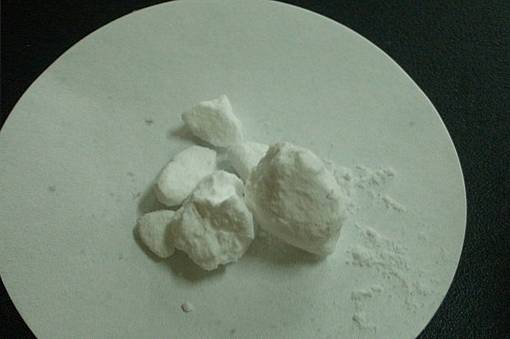
It has been used to reduce the attack of certain insects on wheat plants as it makes them more resistant to these. However, it has been observed that it favors the evolution of methane (CH4), a greenhouse gas, from rice microcultures.
It has been used as a laxative, to increase the duration of local anesthesia, to stop cavities and to help coat surfaces, among other applications.
Article index
- 1 Structure
- 2 Nomenclature
- 3 Properties
- 3.1 Physical state
- 3.2 Molecular weight
- 3.3 Melting point
- 3.4 Density
- 3.5 Solubility
- 3.6 pH
- 3.7 Chemical properties
- 3.8 Other properties
- 3.9 Role of phosphate in the human body
- 4 Obtaining
- 5 Uses
- 5.1 As a basis in organic chemistry reactions
- 5.2 As a catalyst
- 5.3 In agriculture
- 5.4 In medical applications
- 5.5 As a laxative
- 5.6 In veterinary medicine
- 5.7 In obtaining DNA
- 5.8 In various applications
- 5.9 Negative aspect for use in agriculture
- 6 References
Structure
Potassium phosphate is made up of three potassium K cations+ and a phosphate anion PO43-.
The phosphate ion PO43- It is made up of one phosphorus atom (P) and four oxygen atoms (O), where phosphorus has an oxidation state of +5 and oxygens a valence of -2.
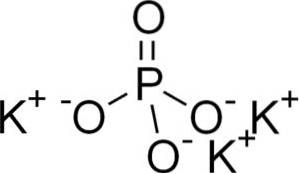
Nomenclature
- Potassium Phosphate
- Tripotassium phosphate
- Tribasic potassium phosphate
- Tripotassium orthophosphate
Properties
Physical state
Colorless or white crystalline solid.
Molecular weight
212.27 g / mol
Melting point
1340 ºC
Density
2,564 g / cm3
Solubility
Very soluble in water: 106 g / 100 g of water at 25 ° C. Insoluble in ethanol.
pH
A solution with 1% K3PO4 has a pH of 11.5-12.3.
Chemical properties
When dissolved in water, potassium phosphate separates into the three potassium cations K+ and the phosphate anion PO43-. The phosphate anion takes a proton from water and the hydrogen phosphate anion HPO is formed4two-. The latter in turn takes another proton from the water and becomes the dihydrogen phosphate anion HtwoPO4-.
PO43- + HtwoO ⇔ HPO4two- + Oh-
HPO4two- + HtwoO ⇔ HtwoPO4- + Oh-
As OH ions are formed- aqueous solution becomes alkaline.
Other properties
In addition to the anhydrous form (without water), it has several hydrated forms; this means that the K molecule3PO4 can be accompanied by one or more water molecules within the crystalline structure.
For this reason it can form, for example, the monohydrate K3PO4.HtwoOr, the trihydrate K3PO4.3HtwoOr, the heptahydrate and nonahydrate.
Role of phosphate in the human body
The phosphate ion PO43- it is the most abundant anion inside cells and plays an important role in energy storage.
The phosphate ion also participates in activities of formation and nutrition of bones and teeth, as it regulates the concentration of calcium in the blood serum and in numerous energy transfer reactions in the cell..
Obtaining
Potassium phosphate can be obtained starting from the reaction between potassium chloride KCl and ammonium phosphate (NH4)3PO4.
Potassium Chloride + Ammonium Phosphate → Potassium Phosphate + Ammonium Chloride
3 KCl + (NH4)3PO4 → K3PO4 + 3 NH4Cl
Applications
As a basis in organic chemistry reactions
Potassium K phosphate3PO4 It has been used in various organic chemistry reactions. For example, it serves in the synthesis of acetylenes starting from dibrominated compounds..
In this synthesis, a dehydrobromination (elimination of hydrogen and bromine) occurs, where K3PO4 anhydrous solid (without water) acts as a soft base and takes two protons from the molecule, the two bromine atoms are removed and the corresponding acetylene is obtained.
C6H5-CHBr-CHtwoBr + 2 K3PO4 → C6H5-C≡CH + 2 KBr + 2 KtwoHPO4
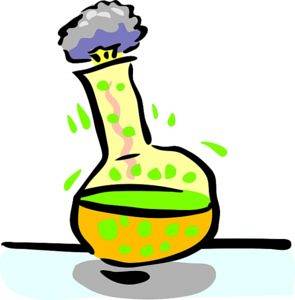
As a catalyst
The K3PO4 It serves as a catalyst in various organic chemistry reactions. For example, it has been used as a solid to obtain biodiesel from used frying oil..
Biodiesel is a fuel similar to diesel but obtained from fats or natural oils used or not.
Potassium phosphate was more effective as a catalyst or accelerator of this reaction than sodium phosphate Na3PO4 and calcium oxide CaO.
In agriculture
The K3PO4 has been used to treat wheat plants and make them resistant to certain pests.
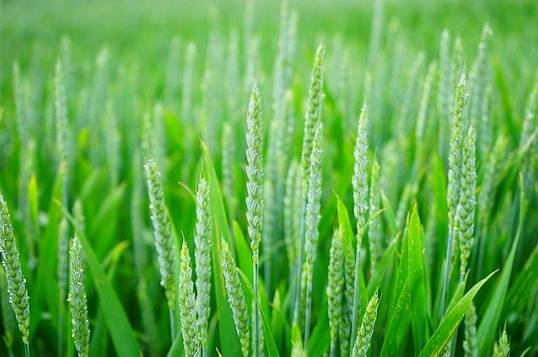
Some researchers treated wheat seedlings with potassium phosphate and it turned out that it induces resistance against aphids. Diuraphis noxia, an insect that attacks these plants.
After applying a dilute solution of K3PO4 less severity of the symptoms caused by these insects and a decrease in the number of aphids feeding on them was observed on the seedlings.

In medical applications
Potassium phosphate has been used to modify the anesthetic effect of lidocaine, a local anesthetic. A local anesthetic is a drug that when applied to an area of the body causes loss of sensitivity to pain in that area..
It was found that the K3PO4 allows to prolong the local anesthesia of lidocaine.
As a laxative
Potassium phosphate increases the fluidity of the intestinal content as it helps to retain water in the intestine, which indirectly induces the contraction of the intestinal muscle.
In veterinary medicine
The K3PO4 is used in animals with diabetic ketoacidosis (a complication of diabetes) to treat hypophosphatemia (low amount of phosphate in the blood).
However, when given in excess it can cause hypocalcaemia (low calcium in the blood), hyperphosphatemia (excess phosphate in the blood), involuntary contraction of muscles, mineralization of soft tissues and kidney failure..

In obtaining DNA
Potassium phosphate has been used as a buffer to purify DNA in genetics laboratories.
DNA is a protein found in cells and contains all the genetic information necessary for the development and functioning of living beings.
By isolating DNA, scientists delve into the study of how hereditary traits are transmitted, which is why potassium phosphate is very helpful.
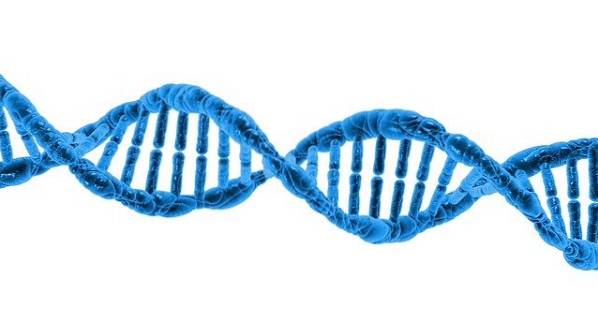
In various applications
Potassium K phosphate3PO4 it serves:
- as a dietary supplement,
- for electrolyte replacement,
- as a buffer, that is, as a chemical system that allows controlling the levels of OH ions- or hydrogen H+ in aqueous solution,
- to slow or inhibit tooth decay,
- as a corrosion inhibitor and antifouling agent,
- as a surface treatment agent and a coating agent,
- as antifreeze,
- in cleaning products.

Negative aspect for use in agriculture
Certain researchers found that adding K3PO4 a microculture of rice increases the emission of methane (CH4) to the atmosphere. Methane is a gas that contributes to the greenhouse effect and increases the temperature of our planet.
References
- U.S. National Library of Medicine. (2019). Potassium phosphate. Recovered from pubchem.ncbi.nlm.nih.gov.
- Panciera, D.L. (2012). Fluid Therapy in Endocrine and Metabolic Disorders. Phosphorus Supplementation. In Fluid, Electrolyte, and Acid-Base Disorders in Small Animal Practice (Fourth Edition). Recovered from sciencedirect.com.
- Shenawi-Khalil, S. et al. (2012). Synthesis of acetylenes via dehydrobromination using solid anhydrous potassium phosphate as the base under phase-transfer conditions. Tetrahedron Letters, Volume 53, Issue 18, 2012, Pages 2295-2297. Recovered from sciencedirect.com.
- Guan, G. et al. (2009). Tri-potassium phosphate as a solid catalyst for biodiesel production from waste cooking oil. Fuel Processing Technology, Volume 90, Issue 4, 2009, Pages 520-524. Recovered from sciencedirect.com.
- Kulkami, M.A. (2012). Mechanistic approach for expeditious and solvent-free synthesis of α-hydroxy phosphonates using potassium phosphate as catalyst. Comptes Rendus Chimie, Vol 16, Issue 2, 2013, Pages 148-152. Recovered from sciencedirect.com.
- Venter, E. et al. (2014). Potassium phosphate induces tolerance against the Russian wheat aphid (Diuraphis noxia, Homoptera: Aphididae) in wheat. Crop Protection Vol 61, July 2014, Pages 43-50. Recovered from sciencedirect.com.
- Bonturi, N. et al. (2013). Sodium citrate and potassium phosphate as alternative adsorption buffers in hydrophobic and aromatic thiophilic chromatographic purification of plasmid DNA from neutralized lysate. Journal of Chromatography B, Volumes 919-920, 2013, Pages 67-74. Recovered from sciencedirect.com.
- Conrad, R. and Klose, M. (2005). Effect of potassium phosphate fertilization on production and emission of methane and its 13C-stable isotope composition in rice microcosm. Soil Biology and Biochemistry, Vol 37, Issue 11, 2005, Pages 2099-2108. Recovered from sciencedirect.com.
- Lide, D.R. (editor) (2003). CRC Handbook of Chemistry and Physics. 85th CRC Press.
- Smokefoot. (2019). Tripotassium phosphate. Recovered from en.wikipedia.org



Yet No Comments